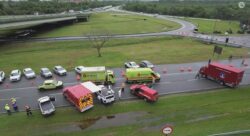Understand which security protocols companies must observe to respond to emergencies efficiently

By Equipe de Redação
Posted in March 23, 2021

Incidents with chemicals – whether dangerous or not – are always very complex, as it is necessary to identify the substances involved and set up the emergency response actions, aiming to mitigate the environmental impacts. Professionals must act quickly and make use of high-tech equipment. Therefore, following national and/or international laws and standards is paramount to ensure efficient emergency response and provide full safety to the team present on the site. Responses to environmental emergencies must always be in line with action protocols as well as in full compliance with Brazilian and international technical standards such as ABNT[1] NBR[2] 14064 and NFPA[3] 472.
International Standards
It is routine for emergency response teams to follow international standards at the time of the occurrence. The National Fire Protection Association (NFPA) is an international non-profit organization that lays down technical standards for fire safety and different types of emergencies. The ultimate goal of the protocols developed is to guarantee the protection of people and the environment where an accident occurs.
Emergency response companies from all over the world observe the protocols set forth by the NFPAs. The association defines everything from fire safety codes to procedures for chemical emergencies with hazardous products, including the safe rescue of victims, the containment of product leaks or spills and much more. The NFPA 472 standard is commonly used as a basis for setting up environmental emergency response actions.
The NFPA 472 standard
The NFPA 472 is a benchmark standard for countries around the world. It includes security procedures for emergency response teams dealing with hazardous products or chemical weapons of mass destruction. It is a means of standardizing the action-taking process in the face of an accident with hazardous materials.
The standard establishes that professionals must utilize specific equipment to identify the type and quantity of the chemicals present in the accident to classify unknown materials and determine the level of complexity of the situation. All information and data captured must be input into a database.
The team must describe the type and extent of the potential damage resulting from the occurrence involving hazardous products, anticipating the behavior of the materials when there are various substances involved. The objective is to ascertain whether there will be any chemical reaction that may trigger explosions or pose greater risks for those involved in the accident. The cold, warm and hot zones must be defined based on information from the scenario and products involved, and by specialist professionals or high-tech equipment capable of measuring the security areas. Only then will it be possible to plan an emergency response with the use of the protective equipment required for the incident as well as the materials to be employed to control the situation. After setting up the possible options for responding to the situation, establishing the process of decontamination of the professionals participating in the action ensues. Finally, the entire procedure must be evaluated to verify the effectiveness of the plans measured and put into practice at the time of the emergency and, also, whether the disinfection process has ensured a positive outcome.
Among international standards, there is a diversity that encompasses security actions and protocols for emergencies of the most various types.
Brazilian standards
In Brazil, the Brazilian Technical Standards Association (ABNT) is responsible for laying down the procedures to be followed by emergency professionals, from a fire to a chemical emergency. One of the standards defining the procedures of response to emergencies that result in environmental impacts is the ABNT NBR 14064.
The ABNT NBR 14064 standard
This standard defines the operational procedures and minimum requirements that must be observed in the quick response to emergencies involving the road transportation of hazardous products. It is essential to highlight the protocols outlined in this standard as, in Brazil, most accidents involving hazardous materials happen on roads.
The ABNT NBR 14064 standard includes any road accident that may cause an environmental impact, whether from hazardous material or not. Among the guidelines to be followed, are the definition of the safety distance from the occurrence; the positioning of the team to guarantee safety for all; the competent bodies that must be notified; the definition of the work zones; the selection and use of the equipment; the implementation of a command post; the definition of the response actions; and the evaluation of procedures carried out.
Concerning road emergencies, there are some important requirements established by ANTT[4] Resolution no. 5848/19. Article 25 determines that, in an emergency, the carrier, the generator, the manufacturer or the person in charge of the hazardous waste must submit any information requested by the public authorities involved in the occurrence. Also, article 29 states that it is necessary to provide safety information about the product being transported as well as guidelines on protective measures and actions in case of an emergency.
Normally, the Emergency Data Sheet contains all the data required for the decision-making during the response to an accident, aiming at saving lives and reducing harm to the environment. Therefore, even if Resolution ANTT no. 5848/19 removed the previously compulsory requirement that the filled-up document should accompany the cargo, having it in such cases continues to be of utmost importance.
However, beyond the rules established by the ABNT, ANTT and other competent agencies, emergency response companies must establish their own security protocols.
Security protocols
Companies need specific equipment for each accident scenario and must define safety protocols for each type of emergency, according to the chemicals involved and the risks they can pose to the professionals and the environment. Even though the teams follow national and international regulations as a cornerstone, market experience stands out when deciding on the best course of action to be taken to resolve an emergency occurrence.
Fully trained professionals, specialized in chemical emergencies and having a great deal of experience in the area are more capacitated to define action protocols for each type of emergency scenario, plus being more skilled and quicker when it comes to identifying the substances involved and anticipating the possible resulting chemical reactions.
Ambipar employs high-tech equipment and technicians that are fully trained and specialize in emergency response with hazardous products. In 2020, over 7 thousand occurrences were responded to – with the shortest response time in the market. With more than 150 bases strategically located worldwide, Ambipar minimizes environmental impacts and helps preserve the world for future generations. It specializes in crisis management involving property, health and the environment.
[1] ABNT: Brazilian Technical Standards Association
[2] NBR: Brazilian Regulatory Standard
[3] NFPA: National Fire Protection Association
[4] ANTT: Brazil’s National Land Transportation Agency




